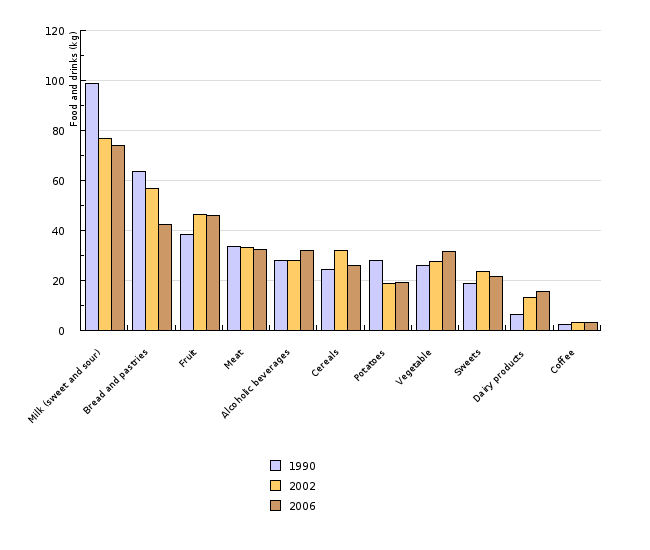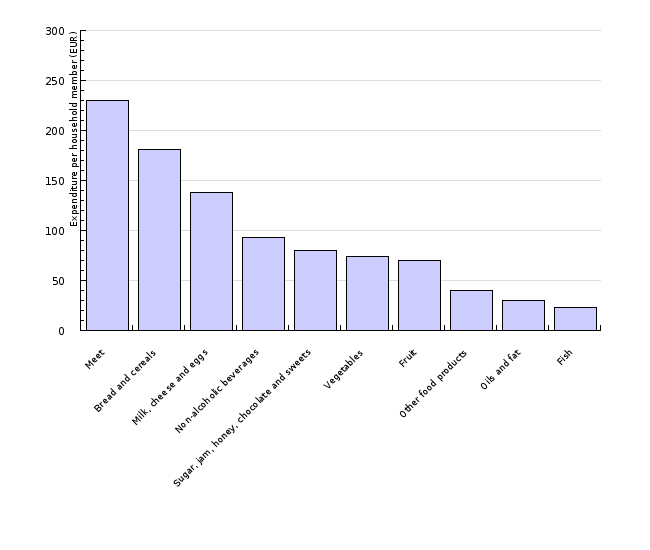[PG07] Quantity of purchased food

Key message

In Slovenia, the share of household expenditure on food and soft drinks is 14%. The largest share of the budget is spent on meat (230 EUR per household member or 27%), bread and cereals (181 EUR per household member or 21%), and milk, cheese and eggs (138 EUR per household member or 16%). The majority of agricultural holdings (84%) are engaged in livestock farming, mainly cattle farming. Organic farming, which is much more environmentally-friendly, became increasingly popular at the end of the 1990's. Until this date, it comprised 5.9% of all utilised agricultural land.
Definition
The indicator shows the changing trends in the quantity and composition of food purchased per individual household member. Besides the changing trends in quantities, the monitoring of the environmental impacts also requires monitoring of the composition of purchased food, as different groups of food have different effects on the environment.
Charts
Statistical Office of the Republic of Slovenia, Statistical Yearbook 2008 (Average annual quantity of purchased food and beverages per household member).
| Milk (sweet and sour) | Bread and pastries | Fruit | Meat | Alcoholic beverages | Cereals | Potatoes | Vegetable | Sweets | Dairy products | ||
|---|---|---|---|---|---|---|---|---|---|---|---|
| 1990 | (kg) | 99 | 64 | 38 | 34 | 28 | 24 | 28 | 26 | 19 | 7 |
| 1995 | (kg) | 94 | 68 | 40 | 30 | 29 | 29 | 33 | 30 | 18 | 9 |
| 1999 | (kg) | 75 | 65 | 47 | 36 | 31 | 33 | 26 | 28 | 25 | 12 |
| 2001 | (kg) | 75 | 61 | 45 | 34 | 30 | 33 | 22 | 28 | 24 | 13 |
| 2002 | (kg) | 77 | 57 | 47 | 33 | 28 | 32 | 19 | 28 | 24 | 13 |
| 2003 | (kg) | 78 | 53 | 47 | 32 | 28 | 32 | 20 | 29 | 24 | 14 |
| 2004 | (kg) | 79 | 50 | 48 | 32 | 30 | 29 | 23 | 30 | 23 | 15 |
| 2005 | (kg) | 77 | 46 | 48 | 32 | 31 | 28 | 23 | 32 | 22 | 16 |
| 2006 | (kg) | 74 | 42 | 46 | 32 | 32 | 26 | 19 | 32 | 22 | 16 |
| Coffee | |||||||||||
| 1990 | (kg) | 3 | |||||||||
| 1995 | (kg) | 3 | |||||||||
| 1999 | (kg) | 3 | |||||||||
| 2001 | (kg) | 3 | |||||||||
| 2002 | (kg) | 3 | |||||||||
| 2003 | (kg) | 3 | |||||||||
| 2004 | (kg) | 3 | |||||||||
| 2005 | (kg) | 3 | |||||||||
| 2006 | (kg) | 3 |
Statistical Office of the Republic of Slovenia, Statistical Yearbook 2008; Average annual allocated assets of households
| Meet | Bread and cereals | Milk, cheese and eggs | Non-alcoholic beverages | Sugar, jam, honey, chocolate and sweets | Vegetables | Fruit | Other food products | Oils and fat | Fish | ||
|---|---|---|---|---|---|---|---|---|---|---|---|
| 2006 | (EUR) | 230.3 | 181.3 | 137.6 | 92.9 | 79.9 | 74.5 | 69.7 | 39.6 | 29.9 | 23.3 |
| 2006 | % | 24 | 18.9 | 14.3 | 9.7 | 8.3 | 7.8 | 7.3 | 4.1 | 3.1 | 2.4 |
Goals
No objectives have been specified yet.
Comment
The most significant environmental impacts of food consumption are indirect, and relate to agricultural production and industrial processing. These include impacts from: energy, water use and waste generation in agriculture and the processing industry; the use of fertilisers and pesticides; emissions from livestock; land use and transportation. Direct impacts of food consumption are lower in magnitude and relate to travel for shopping trips, energy use for cooking and cold storage, and the production of biodegradable and packaging waste.
According to the data provided by the Statistical Office of the Republic of Slovenia, the expenditure of Slovenian households on food and soft drinks presents 14% of all their funds. Considering food and drink, Slovenian households spend the largest share of their budgets on meat (230 EUR per household member or 27%), bread and cereals (181 EUR per household member or 21%), and milk, cheese and eggs (138 EUR per household member or 16%). We spend less on other food products and drinks, the largest share of which is on fish.
Compared to 1990, the quantity of purchased meat, mainly beef, has slightly decreased, but consumption of dried meat products and processed and canned meat increased simultaneously. Since 1990, consumption of dairy products per household member has increased by 136% and consumption of fruit and vegetables has increased by 20%. However, consumption of bread and pastry has dropped by 34%, potatoes by 31%, and milk by 25%.
In Slovenia, more than 84% (63,549) of all agricultural holdings practice various livestock production systems, 60% of which are engaged in cattle farming. Wheat and maize are the most important crops in Slovenia. In 2007, 20,917 agricultural holdings were engaged in the production of wheat, and 28,844 in the production of maize.
In Slovenia, more environmentally-friendly organic farming gained popularity at the end of the 1990's. In the period between 1999 and 2007, the size of land used for such purposes increased from 2,400 ha to 29,322 ha or from 0.5% to 5.9% of all utilised agricultural land. In the last few years, various legal bases were prepared with respect to the production, processing, control and labelling of organic products, which clearly define the goals, principles and general rules for organic production with a view to minimise the human impact on the environment, while ensuring that the agricultural system functions as naturally as possible (wide crop rotation as the condition for efficient use of local resources; extremely strict limitations with respect to the use of pesticides and synthetic fertilisers, antibiotics in livestock farming, food additives, processing aids, and other substances; prohibition on the use of genetically modified organisms; taking advantage of local resources, such as manure as fertiliser or farm-produced feed, selection of plant species and animal breeds that are immune to diseases and adapted to the local conditions, free range breeding systems, out in the open and on the basis of organic feed; use of husbandry practices appropriate to the needs of various animal species). Food can be labelled as organic if at least 95% of its ingredients of agricultural origin are organic.
The EEA Report (Time for action – towards sustainable consumption and production in Europe) states that food and drink cause 20-30% of the various environmental impacts of household consumption. This includes the full production and distribution chain 'from farm to fork'. Within this consumption category, meat and meat products, in different degrees of processing, are the most important sources of impact on the environment, followed by dairy products. As a consequence of increasing meat consumption, intensive farming has become the predominant trend in most EU-15 countries. In the last 40 years, meat consumption has grown from 56 to 89 kilos of meat per average European (EU-15) per year. Consequently, intensive meat production has lead to increased use of agricultural land for meat production, as the production of 1kg of meat requires 10 times more arable land than the production of 1kg of wheat. Thus, the issue of intensive use of agricultural land and negative environmental impacts remains the central issue that must be considered in the food production and consumption processes.
Negative environmental impacts also result from increased use of processed food and pre-prepared meals. The increasing demand for such food products is driven by increasing wealth, smaller households and less free time for food preparation. To continue, some environmental impacts are also caused by a shift in demand from local and seasonal fruit and vegetables towards imported, non-seasonal fruit and vegetables, and a general globalisation of the food market. This increases transportation, cooling and freezing inputs, with a corresponding increase in energy-related impacts.
The demand of European consumers for non-seasonal products and pre-prepared food is gradually changing and becoming oriented towards organic products. Thus, western and central European countries have noted an increase in the group of consumers that are switching to organic and/or locally produced food. Although organic food only represents 1-2% of sales in the EU-15, demand in some countries is outstripping national supply, leading to increases in imports.
Besides the already indicated environmental burdens related to food and drinks, we must also bear in mind that a major part of environmental pollution is a consequence of the excessive use of packaged food. We buy packaged food and drinks more and more frequently, leading to an increase in the amount of packaging waste. Such increase has been noted by most European countries, and on average amounts to160kg per person per year in the EU-15.
Methodology
Data for Slovenia:
Objectives summarized by: /
Source database or source: SI-STAT Database (Household Budget Survey), Statistical Yearbook 2008 (Average annual quantity of purchased food and beverages per household member)
Data administrator: Statistical Office of the Republic of Slovenia
Data acquisition date for this indicator: 15 August 2009
Methodology and frequency of data collection for the indicator: The Statistical Office of the Republic of Slovenia collects data on the quantity of purchased food through a questionnaire entitled 'Household Budget Survey'. Data for the period of three years has been calculated to the middle year and taken into account in the interpretation of the results for the reference year.
The data is published on the SI-STAT Data Portal (Demography and Social Statistics; Level of Living; Household Budget Survey) and in the Statistical Yearbook of the Republic of Slovenia 2008 (Chapter 14.3 Average annual quantity of purchased food and beverages per household member).
Obtained in August 2009.
Data processing methodology: The data for the average annual quantity of purchased food and drink per household member is presented for the first, last and middle year available.
Information concerning data quality:
- advantages and disadvantages of the indicator:/
- relevance, accuracy, robustness, uncertainty: 2
Reliability of the indicator (archival data): 1
Uncertainty of the indicator (scenarios/projections): /
- Overall assessment (1 = no major comments, 3 = data to be considered with reservation): 2
Relevance: 2
Accuracy: 1
Completeness over time: 1
Completeness over space: 1
Other sources and literature:
• Directorate General for Agriculture and Rural Development of the European Commission: http://ec.europa.eu/agriculture/organic/about-site_en
Comparison for Europe and a wider area is derived from:
• EEA Report: Europe's Environment, The fourth assessment – sustainable consumption and production
• EEA Technical Report, No. 1/2008; Time for action – towards sustainable consumption and production in Europe, Summary report of the conference held on 27 – 29 September 2007, Ljubljana, Slovenia
• EEA Report, No. 11/2005; Household consumption and the environment 02 Jan 2006










